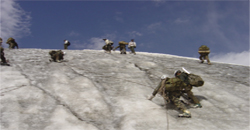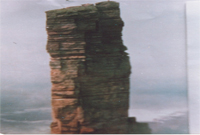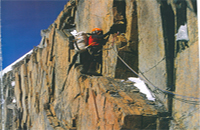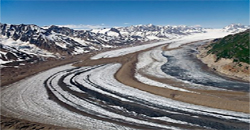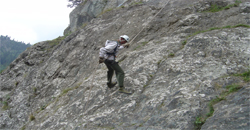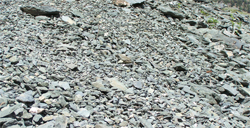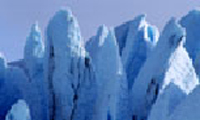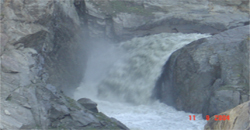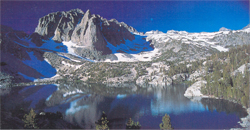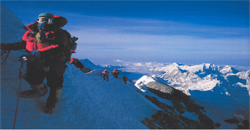Mountaineering Terminology
15. Fixed Rope. Ropes fixed by climber during the course of an expedition, enabling them to pass up and down the difficult face of mountain more quickly. |
|
||||||||||||||
|
16. Gendarme. A free standing pinnacle on an Alpine ridge. Gendarmes may be quite small or immense. |
||||||||||||||
17. Glacier. A huge mass of ice that moves because of its own weight. Glaciers are formed at places where rate of accumulation of snow is more than the rate of melting of snow. |
|
||||||||||||||
18. Gully. The rift between two buttresses caused by erosion may be very wide or narrow and may contain a stream. A gully filled with small stones is a scree gully. |
|||||||||||||||
19. Hanging Glacier. A subsidiary glacier set at a higher level than the valley with great ice cliffs or it may join the main glacier by means of a steep ice wall. |
|||||||||||||||
|
20. Hold. A small irregularity of rock which can be used by a climber for progress or rest. May come in any shape or form, from cracks, ripples, crystals, flakes and so on. Small holds can be used by the finger tips only while larger ones may be grasped by the whole hand. In winter holds may be cut in snow or ice by an ice axe. |
||||||||||||||
21. Ledge. A platform on the rock face which can be used by climber to rest for some time. |
|
||||||||||||||
|
22. Moraine. The banks of stones and other debris found at the snout (terminal), sides (lateral), centre (medial) or bare (ground) of a glacier. Moraines are formed of boulders, mud and even old ice, crushed together by the grinding action of the glaciers movement. |
||||||||||||||
23. Overhang. A rock face or ice wall of gradient more then 90 degree. |
|
||||||||||||||
24. Pitch. The distance between two belays that a climber has to travel. |
|||||||||||||||
|
25. Rappelling. Descending down a rock face or ice wall with the help of rope is called rappelling. Rappelling is also known as abseling. |
||||||||||||||
26. Rib. A small ridge on a mountain face or crag. In rock climbing it is used somewhat indiscriminately and can mean almost any small protuberance. |
|||||||||||||||
27. Scree. Loose rock eroded from a mountain and found in steep slopes below cliffs. Can be very awkward to climb and descent though scree. |
|
||||||||||||||
|
28. Serac. A pinnacle or tower of ice. Seracs are found in ice falls and at the edge of ice cliffs. They are unsuitable for climbing and are potentially dangerous, as they fall off periodically. |
||||||||||||||
29. Slab. A flat area of rock inclined approximately between 30’ and 75’. May form a pitch of a climb or be large enough to hold several climbs. |
|
||||||||||||||
30. Snow line. An imaginary line joining places of same height above sea level above which snow is found through out the year. |
|||||||||||||||
|
31. Snout. Base of glacier from where glacier stream starts flowing is called snout. |
||||||||||||||
32. Tarn. Lake found in mtns. |
|
||||||||||||||
|
33. Traverse. Moving laterally across terrain instead of ascending or descending. |
||||||||||||||
34. Verglas. Thin ice lying on rocks and making climbing difficult. Similar to black ice on roads in appearance and effect. |
|||||||||||||||
35. Wall. The steep face of a mountain or buttress. |
|||||||||||||||
36. White Out. A dangerous condition in winter when falling and drifting Snow, or poor visibility cause the horizon to merge with the ground and the sky. It is difficult to then orientate oneself and very easy to walk over an edge. |
|||||||||||||||
37. Wind Chill. The effect of low temperature is compounded by the heat extracting effect of the wind and the two in combination should be taken into account when considering the weather. Charts, as shown below are available to compute such combinations.
|
|||||||||||||||
38. Wind Slab. A dangerous snow condition when an upper layer of firmer snow is loosely attached to a lower layer. The upper layer can then break away in slabby chunks at a climbers touch, causing an avalanche. |
|||||||||||||||
Training
The Jawahar Institute of Mountaineering and Winter Sports (JIM&WS).
Contact Us
The Jawahar Institute of Mountaineering and Winter Sports (JIM&WS)
Address: Nunwan Pahalgam (J&K)
Telephone: 01936-243129
01936-243129 (Training Section)
01936-243002 (PA to Principal)
9906967831 (Training Clerk)
9906967822 (Sub centre, Sanasar)
9906967821 (CPIO)
E-mail CPIO: principal@jawaharinstitutepahalgam.com
Fax:01936-243129
E-mail: principal@jawaharinstitutepahalgam.com
© Copyright JAWAHAR INSTITUTE OF
MOUNTAINEERING & WINTER SPORTS NUNWAN, PAHALGAM.Corporate Mail
Design, Development and Hosting of Website by Say Technologies




